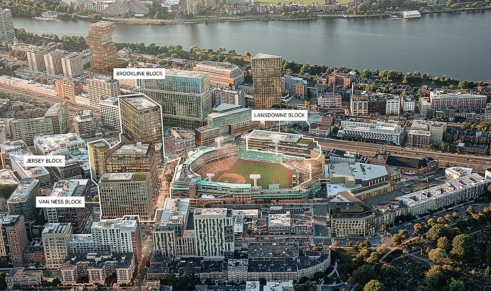
Red Sox plan for area around Fenway Park.The city has pledged to resume giving each new real estate development in the Fenway its own community review board, but the effects of the super-committee the city is branding an experiment postmortem could be felt for decades to come.
The Fenway CAC is a board of community members originally gathered to review the 109 Brookline Avenue life sciences development. In response to calls for a more comprehensive analysis of development in the Fenway, the city used that same group to review two other large projects nearby instead of assembling individual Community Advisory Committees (CACs).
While that move was well-received by the community, board members and residents began raising objections when the same board, now titled the Fenway CAC, was tapped for other projects like reviewing zoning changes and transportation plans.
The Boston Planning and Development Agency (BPDA) announced in a statement for a January 13 article in The Boston Guardian that it would stop assigning the Fenway CAC to new projects.
Members report, however, that they’re yet to receive official confirmation of this, and even if the Fenway CAC takes no new projects, its influence will be felt for years through the projects it has already accepted, some of which don’t have easy ways to replenish or replace members.
“The CAC isn’t really being wrapped up. The Fenway Corners project has 15 years, maybe 20 until it's built out,” said Tim Horn, president of the Fenway Civic Association (FCA) and a Fenway CAC member. “Anybody there is on the hook for that one since they didn’t do a master plan which would give us a formal way to transfer members through the years. Two decades is going to see members of that group move on, die or retire.”
None of the Fenway CAC members interviewed for this article said they’d received official communication confirming that the board would not be taking on more projects.
The BPDA’s statement framed using the same group of people for many projects as “a pilot with the goal of creating a more equitable and inclusive engagement process by involving a larger section of the community,” but that seemed to come as a surprise to the committee’s members.
“No one said it was a pilot program,” said Horn. “First, they said for three projects, and then they started pulling in more. It sounded like we were going to be doing every project from then on, and that’s when we started pushing back and trying to get more residents on for better representation. By the time we were reviewing zoning it was clear that some of us were pretty tired of it being the same group of people.”
“It wasn’t really presented to me as a pilot program, not in the conversations I had with other members when I joined,” said Kathy McBride, a member of the FCA board and Fenway CAC. “When I got on the committee there was so much unrest and dissension about it, the discussion was already moving toward ‘this is not working,’ ‘this is not a good idea.’”
The BPDA initially said it would provide comment for this article, but never sent the promised statements and did not respond to further communication.
“It’s far from done. The whole Fenway Corners project is on its agenda, and that’s going to be a huge community review undertaking,” said Dolores Boogdanian, president of the Audubon Circle Neighborhood Association and a Fenway CAC member. “The BPDA is always in some weird catchup mode. If the city were actually planning ahead, we’d all be better off, and I wouldn’t have to spend 65% of my time going to hearings and meetings worried about what the next decision is going to be.”